
According to McKinsey, generative AI adoption is booming, with 65% of companies integrating it into their processes. However, turning this technology into measurable business outcomes remains challenging for many leaders. This guide will help you harness generative AI software development to achieve your business goals. You’ll find ground case studies and actionable strategies that prove why generative AI changes everything for modern companies.
Generative AI for Software Development: Returns for Business Owners and Executives
Generative AI (GenAI) has been receiving a lot of attention lately, serving as a showcase for artificial intelligence in general for a broad user audience. According to a study conducted in six countries on different continents (Argentina, Denmark, France, Japan, the UK, and the USA), about half of online users in the surveyed countries are aware of perhaps the most famous AI tool today, ChatGPT. Moreover, in the USA, for example, 7% of respondents use it daily.
Briefly walk through the main features of GenAI.
What is Generative AI?
Generative AI creates new data, such as text, images, or audio, by learning patterns from existing data. It contrasts with traditional AI, which focuses entirely on classifying, analyzing, and interpreting existing data, for example, predicting outcomes or identifying objects in images.
Traditional AI employs discriminative models for tasks like classification, whereas generative AI uses generative models to produce data resembling real-world examples.
Here are the basic differences between discriminative and generative models:
- Discriminative AI models (e.g., logistic regression, neural classifiers, SVMs) focus solely on distinguishing between different data classes and optimizing classification tasks.
- Generative AI models (e.g., variational autoencoders, GANs) learn the underlying data distribution and the joint probability of inputs and outputs, enabling them to generate new data.
It is essential to pay attention, in particular, to the following core concepts to understand how generative AI works:
- Generative Adversarial Networks (GANs): A model architecture that combines two neural networks (generator and discriminator). The generator creates data, while the discriminator evaluates its authenticity, improving both models iteratively. As a result, utilizing a generator and a discriminator, GANs can create realistic outputs, such as lifelike images.
- Large Language Models (LLMs): Process vast text datasets to generate coherent and contextually relevant text, enabling applications like chatbots and automated content creation. LLMs, like the well-known GPT (generative pre-trained transformer), generate human-like text by understanding and predicting language patterns.
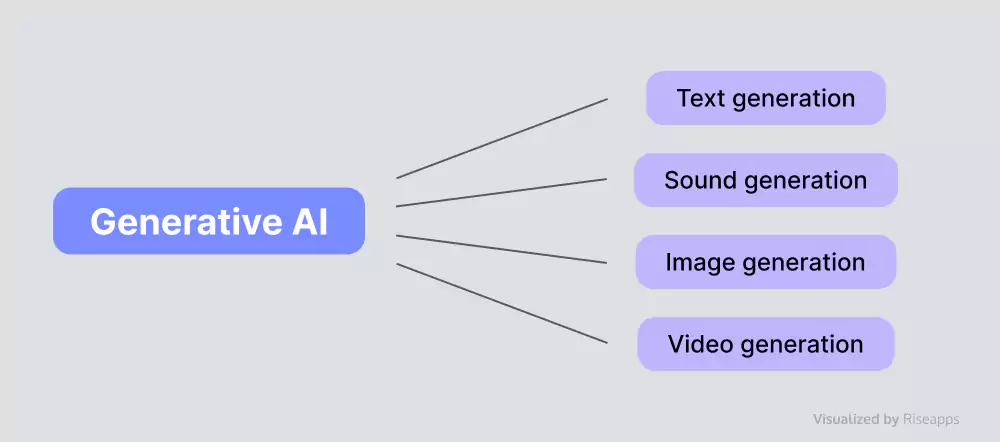
Among the capabilities of generative AI that can be crucial in developing business apps, it is worth keeping the following in mind:
- Content Creation: Generates realistic images, coherent text, or lifelike voices.
- Data Augmentation: Expands datasets by generating synthetic but realistic data for training models.
- Personalization: Adapts outputs to user preferences or specific requirements, such as tailoring text, recommendations, or image styles.
Generative AI’s ability to create rather than only analyze fosters creativity and CX personalization across industries. How are things going with the realization of this technology’s capabilities?
Generative AI in Software Development: Business Benefits
The current state of enterprise generative AI adoption reflects a pivotal moment, with one-third of organizations now regularly using GenAI in at least one business function. Highly likely, your business also can’t afford to ignore this transformation, as 40% of companies are increasing their AI investments specifically due to advances in generative AI.
The enterprise generative AI market has experienced unprecedented growth, with spending surging to USD 13.80 billion in 2024, an increase from USD 2.30 billion in 2023. Here’s what’s driving this explosive growth:
- 72% of decision-makers expect further widespread implementation of generative AI tools shortly
- 51% of enterprises have adopted code copilots as their primary use case
- 31% have implemented support chatbots for enhanced customer service
Bloomberg’s forecasts for revenue in the general AI market, not just the enterprise segment, show an even more promising picture.
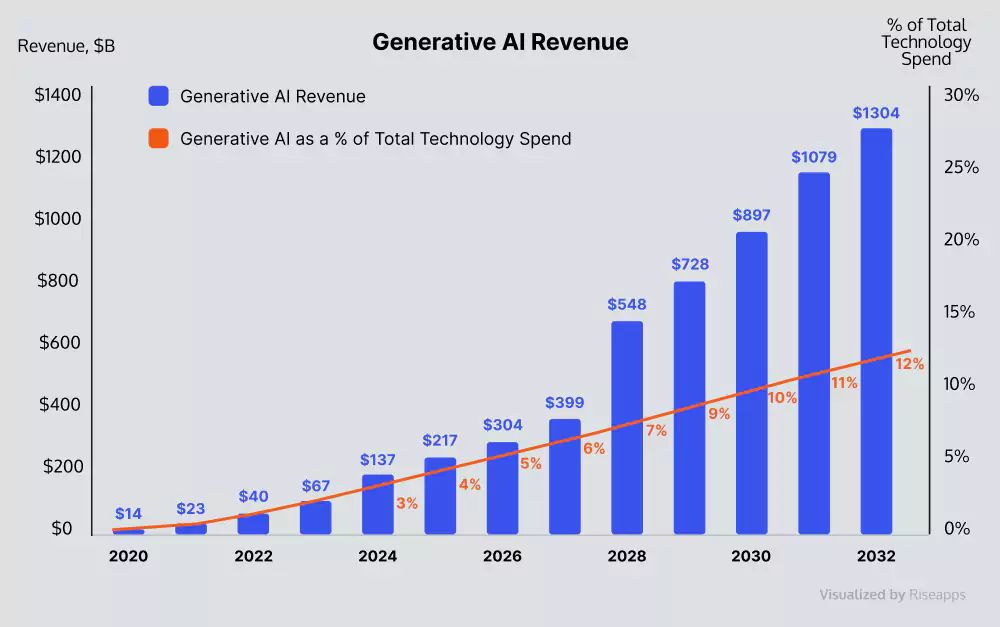
Key business drivers and ROI metrics give grounds for optimism, allowing you to expect that your investment in generative AI can deliver substantial returns. Organizations are experiencing an average return of USD 3.50 for every dollar invested in AI.
The most successful implementations focus on these key value drivers:
- Productivity Enhancement: Employees using generative AI save approximately 1.75 hours daily
- Cost Optimization: 36% of financial services professionals report reducing annual costs by over 10%
- Customer Experience: 73% of consumers anticipate enhanced personalization through AI
- Operational Efficiency: AI can automate 60-70% of current employee tasks
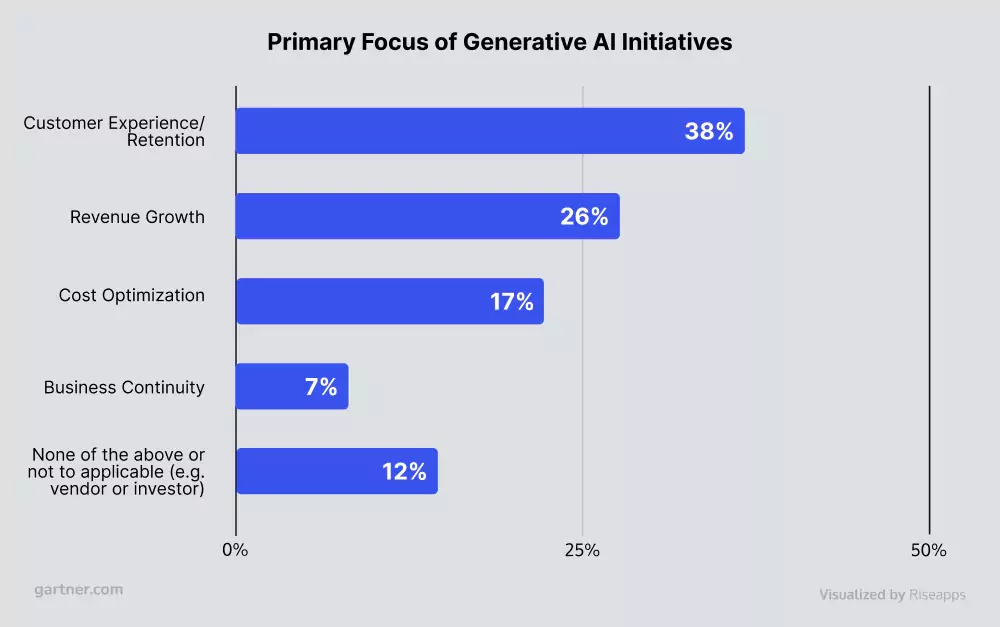
You can see the connection between operational and financial results of implementing generative artificial intelligence in the results of the recent study by the National Research Group, commissioned by Google Cloud:
Productivity Gains: 45% of organizations report doubled employee productivity with generative AI.
Enhanced User Experience: 85% note higher engagement and satisfaction alongside measurable user experience improvements.
Improved Security: 56% claim better threat detection and faster resolution due to enhanced security measures.
Rapid Implementation: 84% of companies implement generative AI use cases from concept to production within six months.
Revenue Growth: Among organizations using generative AI in production, 86% report at least a 6% increase in annual revenue.ROI Insights: 74% of enterprises are already seeing returns, with 30-35% expecting ROI within the next year.
Generative AI is delivering tangible business value across multiple dimensions. This trend increases the relevance of GenAI-based projects to companies’ AI software development strategies.
Today, businesses should have AI strategies, as they need to create and establish the appropriate infrastructure, including for long-term data work. This approach requires the concerted efforts of business owners and managers, in-house teams, and AI strategic consulting partners, but it can bring significant results in the long run.
Solving the Most Common Challenges When Using Generative AI
While the potential of generative AI is immense, you’ll need to be prepared to address several key challenges. Here’s how to tackle the biggest hurdles:
Data privacy and security
76% of business leaders worry most about data privacy and security. Implement security best practices, including information encryption, multi-factor authentication, and stringent security protocols. 69% of organizations are already incorporating similar measures in their partner agreements.
AI integration complexity
56% of organizations prioritize risk mitigation during implementation. Start with smaller, well-defined projects before scaling. Collaborating with experienced AI software developers, prioritize architecture solutions that enable scalability, and interoperability with existing systems, and test integrations extensively to avoid disruptions.
Team adoption
Provide your staff with comprehensive training and AI consulting support helping to eliminate knowledge gaps and biases. Consulting sessions, AI product workshops, and Discovery phases at the start of generative AI software development projects – are examples of activities that will help managers and employees of companies properly prepare for working with AI-based software.
Ensuring compliance
Regulation of the AI field is steel infantry but will intensify. 99% of surveyed businesses expect medium to high risk from regulations affecting their generative AI implementation. Careful handling of training data sources, appropriate attitude to intellectual property rights, and compliance with ethical standards will help your company prevent issues associated with generative AI.
Generative AI in Software Development: Industry-specific Use Cases
Your industry’s competitive environment can demand more than generic AI solutions. Different sectors are using generative AI in unique ways to solve unique challenges and drive measurable results.
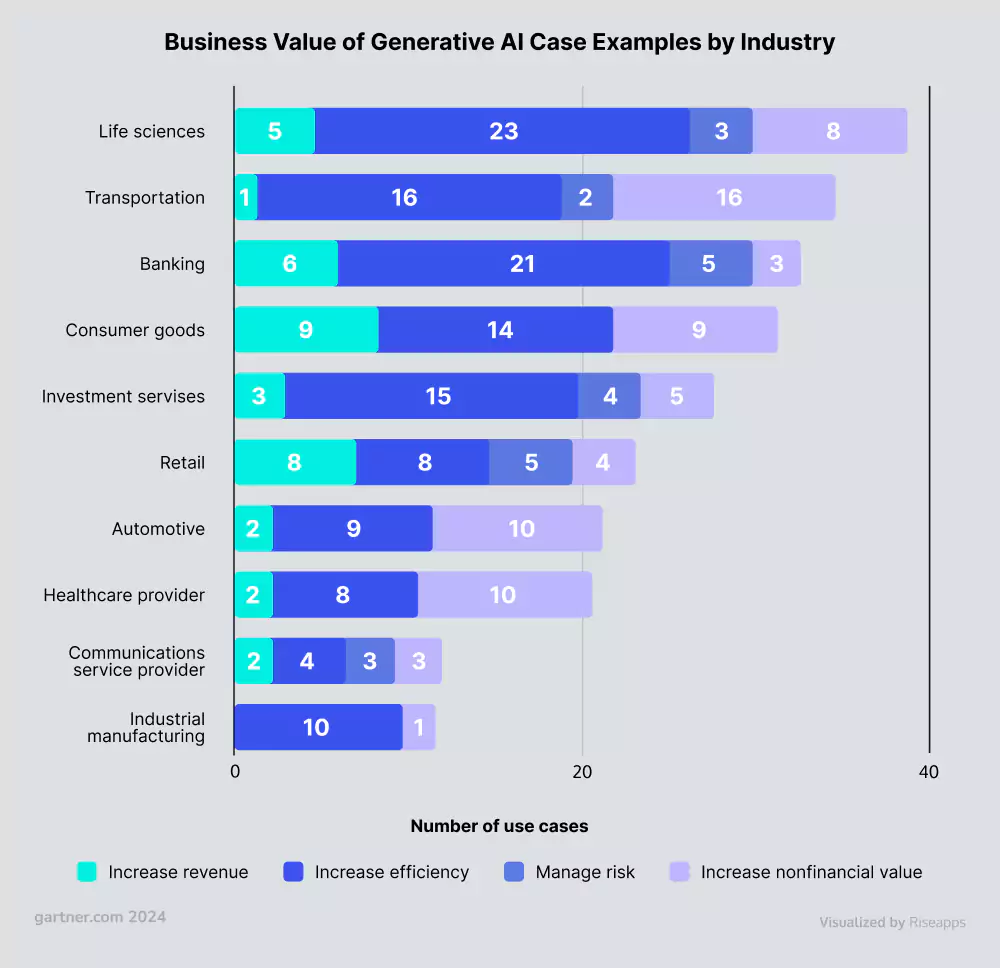
Healthcare
Personalized medicine: AI technologies in healthcare bring particular value to comprehensive telemedicine platforms that are easily accessible to patients. AI-powered healthcare systems provide doctors with real-time insights from vast datasets, analyzing patient data for precise diagnoses and generating tailored treatment plans, improving patient outcomes.
24/7 real-time health assistance: AI-based chatbots enhance patient engagement, offering accurate preliminary diagnoses and improving telemedicine experiences. Advanced virtual assistants become personal health advisors for individuals, creating targeted content, answering complex queries, and supporting conversations.
Drug discovery and clinical trial optimization: GenAI speeds up drug discovery. AI-driven models like GANs expedite medicine design, simulating molecular structures and identifying promising candidates, reducing costs and time by up to 50%. Using AI, specialists may develop possible scenarios and model the interaction of various pharmaceuticals.
E-learning
Automated educational content generation: According to research student participation increases by 84% with AI-powered educational content delivery. Multi-language support for content creation also extends the capabilities of custom learning management systems (LMS). AI-generated scenarios offer students immersive learning experiences.
Personalized learning paths: GenAI enables adaptive learning considering student needs, suggesting individual learning plans depending on individual features, performance, and preferences. AI solutions can create programs and offer a set of resources that match personal strengths and weaknesses. Interactive formats also increase interest in new knowledge.
Real-time assessment and feedback: E-learning platforms can use AI-generated quizzes and tests that adjust in difficulty according to student proficiency. AI bots simulate one-on-one tutoring, providing personalized support for students. AI solutions generate conversational scenarios and support dialogues to improve linguistic fluency.

Sports & Fitness
Real-time personal virtual coaching: State-of-the-art fitness apps provide users with their virtual trainers. Based on athlete performance data, an AI-powered system creates data-driven simulations to refine training regimes and offers personalized training plans, adjusting them depending on conditions and preferences.
Customized content creation: Sports and fitness enthusiasts can receive a variety of content from videos featuring their favorite top athletes to detailed schedules and tips on training, diet, and daily routine.
Athletes and fan engagement: Generative AI is great for creating scenarios, gamification features, virtual rewards, and coming up with various flash mobs and challenges that increase motivation for fitness and sports
iGaming
Real-time player sentiment analysis: AI in iGaming platforms evaluates player behavior and emotions, enabling tailored retention strategies, additional offerings and activities, and improved satisfaction.
Enhanced player engagement: Customized AI-generated content, interactive features, and available personalized settings create dynamic and immersive gaming experiences.
Personalized gaming experiences: AI analyzes preferences and statistics to suggest games, strategies, features, or specific recommendations for boosting player satisfaction and loyalty.
Finance
Fraud prevention: GANs simulate fraudulent activities to strengthen detection systems. In this way, the business owners and executives obtain information about potential security vulnerabilities to eliminate them.
Customized financial and investment recommendations: 71% of CFOs already use generative AI solutions for better decision-making. Generative AI models offer strategies, plans, and separate operations based on recent forecasts and predefined priorities.
Risk assessment: Predictive models assess investment risks more accurately through simulating AI-generated scenarios. This practice is suitable for complex dynamic environments since AI models can generate a large number of variants of subject behavior and probable events.
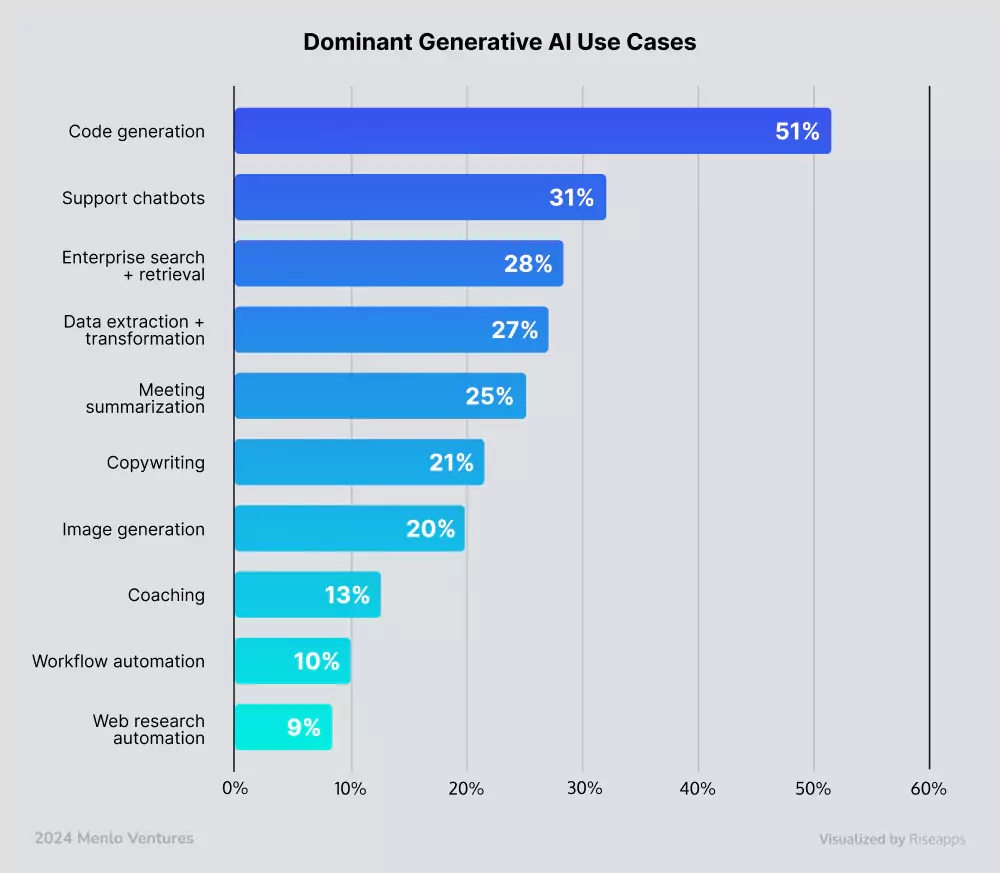
Manufacturing
Product design: AI solutions generate innovative prototypes faster and with more options, allowing for rapid iteration and customization.
Supply chain optimization: Generative AI models assist in simulating scenarios to manage inventory and logistics effectively, as well as find potential weak links in supply chains.
Creating documentation and content: Generative AI solutions can free staff from the painstaking work of writing documentation and drawing auxiliary diagrams and illustrations. It is also worth considering the capabilities of GenAI products for creating introductory and educational content.
Clean energy
Grid optimization: Based on analyzing consumption patterns, creating energy distribution models helps streamline resource allocation, improve grid management, and reduce waste.
Renewable development: Generative AI software is used when designing more efficient solar panels and wind turbines and defining the most appropriate places to install them. The ability to generate multiple prototypes facilitates searching for beneficial solutions
Energy consumption modeling and forecasting for renewable assets: Power engineers can use GenAI in forecasting needs for wind and solar energies and building complex models that predict the impact of different energy sources on sustainability goals.
Construction
Design automation: Generative AI creates optimized building designs based on environmental data and material efficiency. Generative AI visualization solutions provide clear, detailed models to help stakeholders review designs effectively.
Safety ensuring and risk analysis: By analyzing facility characteristics and environmental conditions, GenAI models create scenarios to predict possible events and identify potential hazards before they become issues.
Project management: Project managers may apply generative AI software simulating construction workflows to optimize timelines and resource allocation.
Generative AI for Developers and Project Founders
Leveraging generative AI in your development workflow can transform how your team builds software. You may consider applying generative AI models in the following processes.
Automating code generation and debugging
Your development team can save work hours through automated AI code generation and debugging. The generative AI technologies excel at:
- Generating code snippets from natural language prompts
- Identifying and fixing common coding errors
- Creating reusable code components
- Automating routine programming tasks
- Streamlining bug detection and resolution
GenAI-backed code review and refactoring
AI can analyze entire codebases and suggest potential improvements to transform your code review process. Research indicates that AI-powered code review tools automatically detect up to 60-70% of common coding issues and help maintain consistent code quality across projects.
Generative AI for collaborative coding and knowledge sharing
GenAI enables seamless knowledge transfer across software engineers or development teams. Platforms leveraging generative AI can analyze thousands of coding scenarios, providing contextual suggestions that help developers learn and implement best practices more effectively.
Streamlining software documentation creation with GenAI
Generative AI tools can automatically create and support technical documentation, reducing documentation time and ensuring content quality and formatting consistency. This feature proves especially valuable when maintaining legacy systems and updating existing documentation.
Improving UI/UX design through GenAI
With AI tools, you can enhance the UI/UX design workflow by analyzing user data and suggesting optimal layouts. AI-powered design solutions help create more customized, responsive interfaces and significantly reduce design iteration time.
Generative AI for quality assurance
The capabilities of generative AI, including the automated creation of diverse test scenarios, allow the implementation of comprehensive QA (quality assurance) strategies. GenAI contributes to the following QA activities:
- Automated test case generation
- Complete coverage analysis
- Real-time bug detection
- Performance optimization
- Security vulnerabilities assessment
Generative AI Whitelabel Solutions: Fast Launch and Cost Savings
Looking to accelerate your AI implementation timeline, you can consider a choice between custom and white-label generative AI solutions. Whitelabel solutions are changing the way businesses adopt generative AI. These ready-to-deploy platforms can help you reduce development time and budget compared to solutions built from scratch.
In addition to shortening the time to market, whitelabel solutions help you strengthen your brand position and protect data ownership. Scalability deserves a closer look. Your white-label solution grows naturally with your business without putting extra strain on your internal teams. This flexibility keeps costs down while maintaining consistent performance at any scale.
The Voice.AI is an example of how white-label AI voice communication solutions can boost business operations.
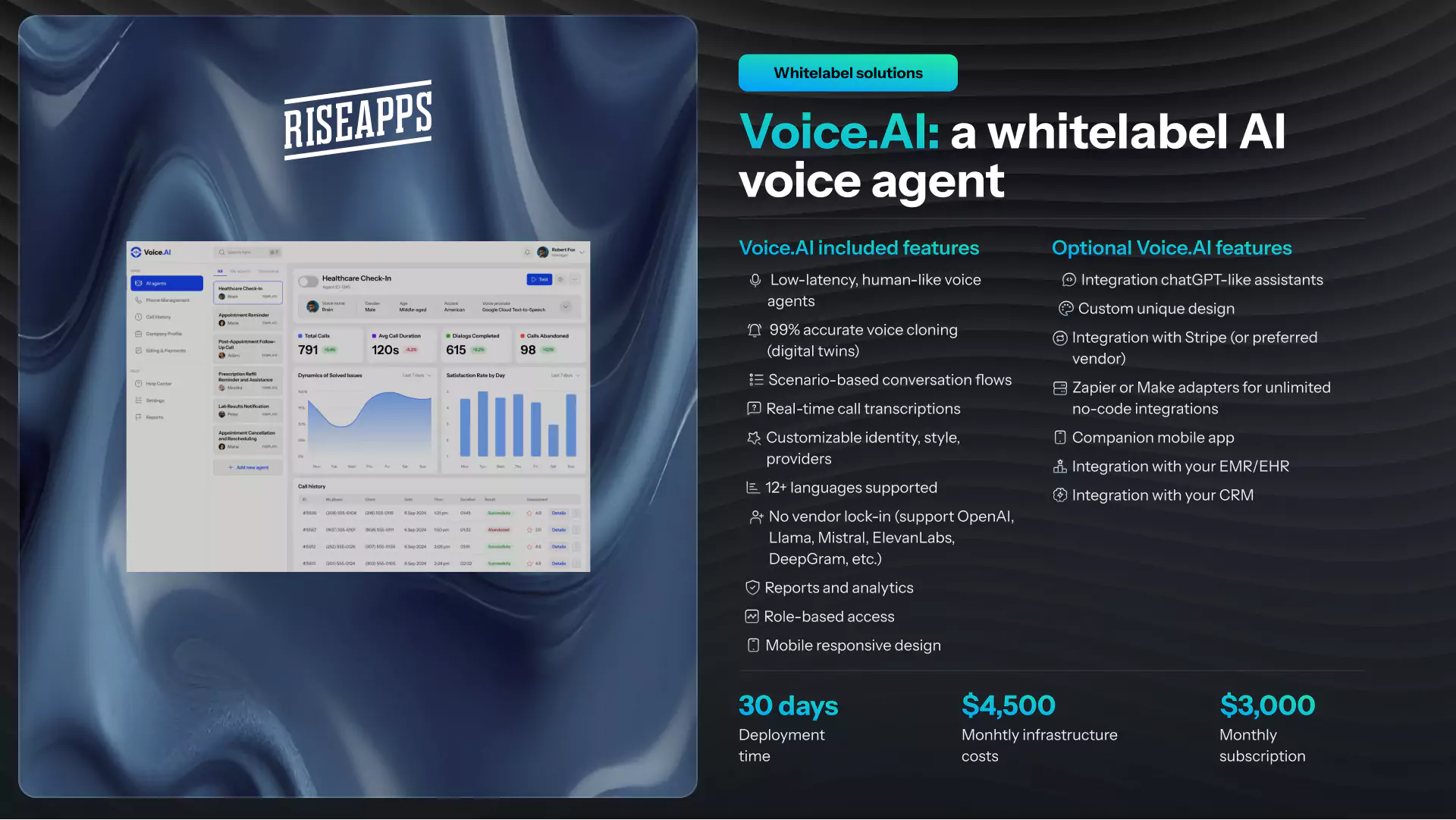
This voice agent uses advanced ASR (Automatic Speech Recognition), NLU (Natural Language Understanding), and TTS (Text to Speech) technologies to deliver results.
You can learn more about how whitelabel generative AI software solutions work from a short video.
By choosing Voice.AI, you can launch your low-latency, human-like voice agent only 30 days after the first call, minimizing initial costs. Moreover, Voice.AI can combine the advantages of several generative AI models at once, as this white-label solution may optionally be integrated with virtual assistants, like ChatGPT, based on large language models.
Generative AI Tools for Software Development
The latest generative AI tools are reshaping software creation when expanding development capabilities. For example, a recent Stackoverflow survey found that 77% of professional developers are already using AI tools (63%) or planning to use them in the near future (14%).
The infographic below shows how professionals rate the advantages of using AI tools.
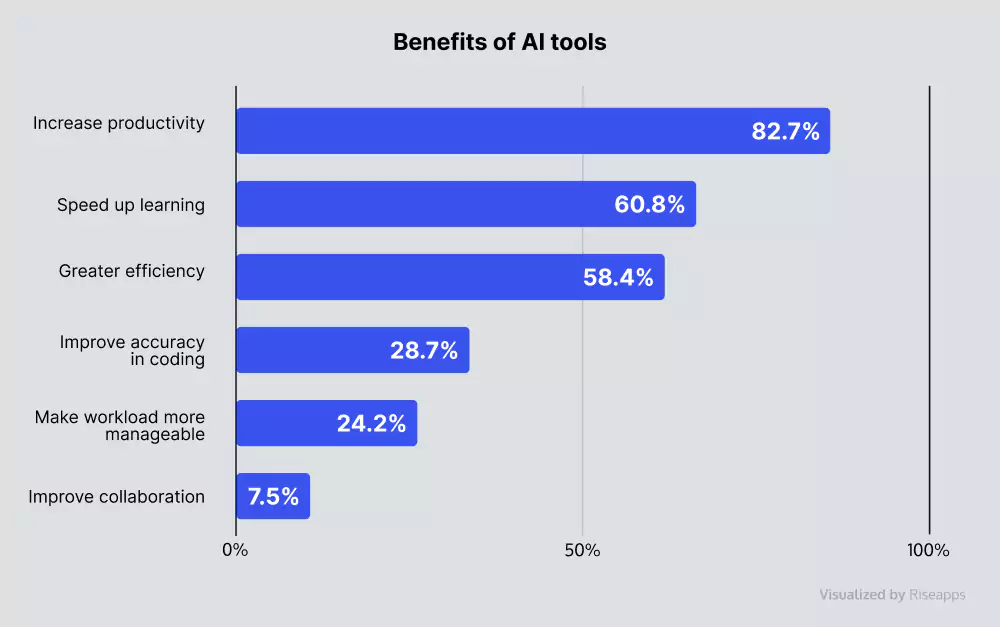
According to the above survey, generative AI tools took the leading place in the arsenal of professional coders. For example, 82% of those using AI tools use them to write code, 40% to document code, and 35% to generate synthetic data or content.
The range of generative AI tools is constantly updated. To give you an idea of the main categories of such tools, check out some typical examples.
Enterprise-grade AI tools for software development:
- GitHub Copilot, running on OpenAI’s Codex model, generates code from natural language prompts across multiple programming languages, including Python, JavaScript, and Java
- Amazon Q Developer (formerly CodeWhisperer) helps to create autonomous agents for specific tasks, handling everything from testing schedules to API integrations
Open source and community AI tools for software development:
- Code Llama: Meta’s specialized coding assistant built on Llama 2
- Polycoder: Carnegie Mellon’s open-source alternative solutions
- Mintlify: Helpful for documentation automation
- Tabnine: Focuses on security vulnerabilities and other security aspects in AI-assisted development
Specialized generative AI Tools for specific software development tasks:
- IBM watsonx Code Assistant provides Code Assistant for Z, which specializes in modernizing legacy applications, and Code Assistant for Red Hat Ansible, which focuses on infrastructure management and automation
- CodeWP stands out in WordPress development, generating PHP, JavaScript, and jQuery code optimized for WordPress environments
Your choice of generative AI tools should match your project’s requirements and team’s expertise. These factors matter when selecting AI tools:
- Integration capabilities with existing workflows
- Security and compliance features
- Affordable solutions at scale
- Team learning curve and adoption time
Currently, any software development team caring about code quality cannot yet rely solely on AI tools. The involvement of skilled engineers remains essential to reviewing AI-generated code, detecting and fixing bugs, and, even more so, coming up with complex solutions.
At the same time, professionals highly appreciate advanced generative AI tools that are transforming the software development process today. These tools help significantly reduce code generation time, detect bugs with a high accuracy rate, and ensure IDE integration for compatibility with the major platforms.
Generative AI Software Development: Success Stories and Lessons Learned
Real-world success stories demonstrate how generative AI elevates businesses across industries. Here are three groundbreaking examples from Riseapps highlighting the practical outcomes of applying GenAI.
Black Doctor 24/7 Case Study: Telemedicine Platform with Personal AI Assistance
Black Doctor 24/7 is a cross-platform telemedicine solution with an AI assistant that connects African-American patients to culturally aligned doctors.
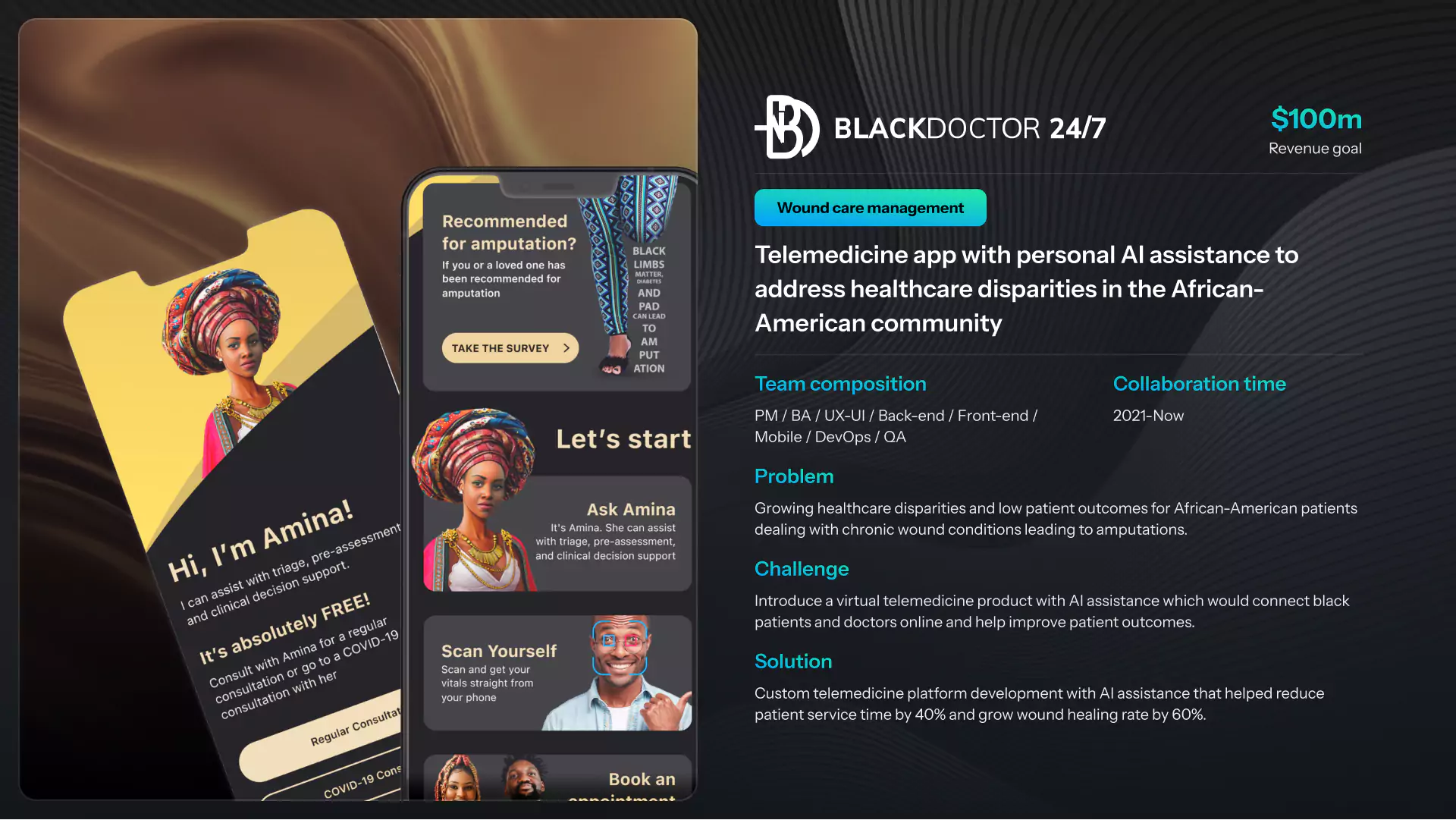
Customer Requests:
- Build a cross-platform telemedicine solution in six months
- Include an AI-driven virtual assistant for patient care
- Integrate third-party tools like video streaming and chat platforms
- Ensure 100% HIPAA compliance
Project Challenges:
- Delivering a robust feature-rich product within a tight six-month timeline
- Achieving seamless third-party tool integration
- Ensuring high security and regulatory compliance
Riseapps Solutions:
- HIPAA-compliant telemedicine platform with mobile and web apps
- Amina, an AI assistant for symptom analysis and appointment guidance
- Integrated Agora for video calls and GetStream for real-time chat
GenAI Project Highlights:
- AI-powered virtual assistant for automated self-assessments
- Real-time data-driven recommendations to improve care
Project Results:
- Launch the comprehensive telemedicine platform on schedule
- Reduced care delivery costs by 40%.
- Screened over 30,000 patients for critical conditions
BlackSwan Technologies Case Study: AI Operating System for Risk Management
The ELEMENT platform from BlackSwan Technologies is an AI-driven risk management AI operating system that speeds up transaction processing and reduces fraud detection costs.
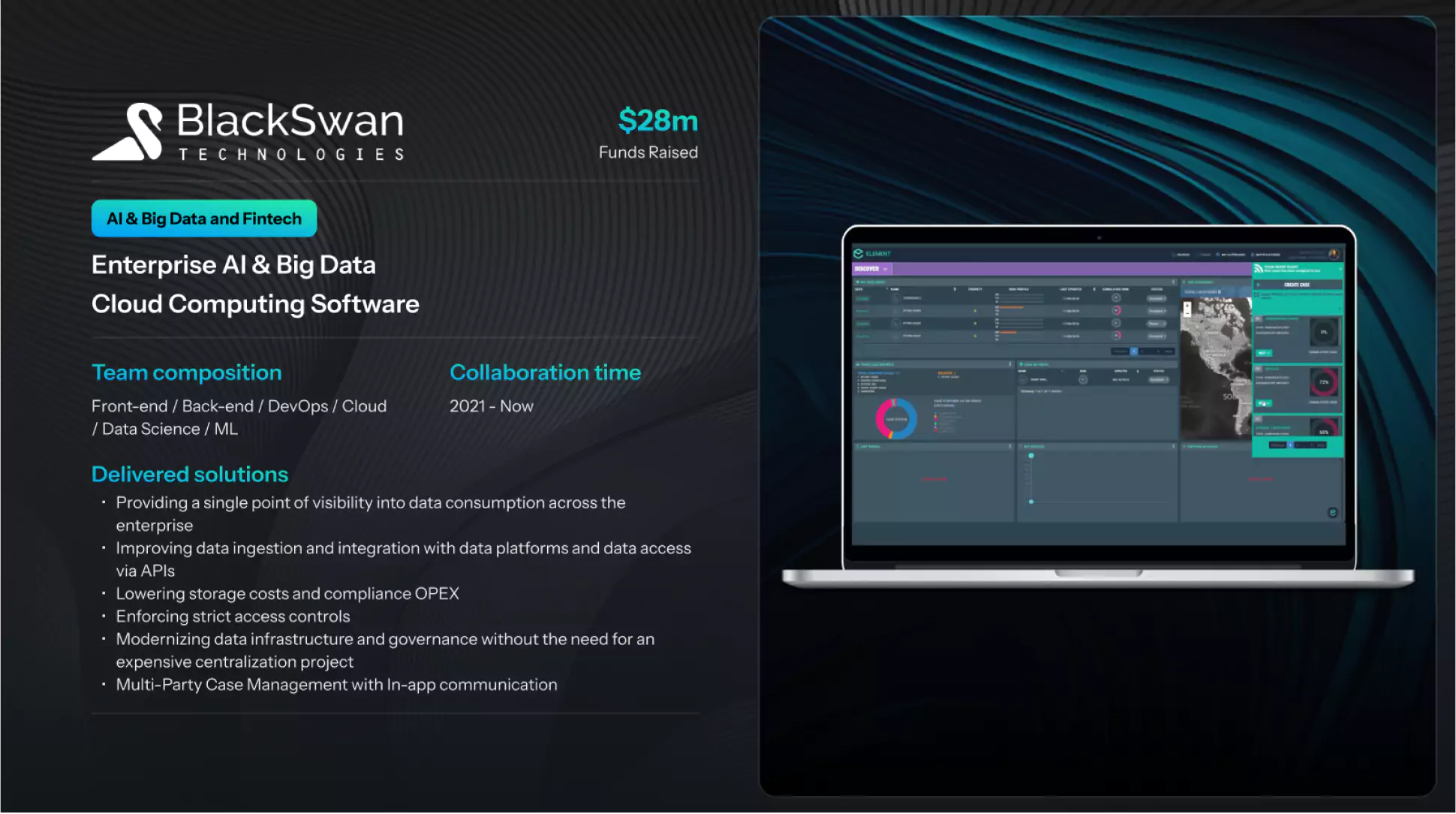
Customer Requests:
- Enhance the ELEMENT™ platform for improved scalability, security, and compliance
- Simplify deployment and ensure data privacy to gain client trust
- Add transaction monitoring to prevent money laundering risks
Project Challenges:
- Complex deployment and security issues causing inefficiencies
- High processing times for large data sets
- Need for advanced fraud detection and risk management features
Riseapps Solutions:
- Transaction monitoring with event management and error handling
- Migrated infrastructure to Azure for better performance and security
- Abstract architecture for seamless data integration and scaling
GenAI Project Highlights:
- AI-driven insights for fraud detection and AML sensitivity
- AI-based automated, scalable solutions for compliance and risk analysis
Project Results:
- 50% reduction in false positives for AML alerts
- Capability to process 6 million transactions per hour
- Secured $28 million in funding and major clients like PepsiCo and Johnson & Johnson
VOXX Case Study: AI-Powered Athletic Footwear Solution for Professional Athletes
VOXX is an AI footwear solution with advanced sensors for performance tracking that offers AI-based training and injury prevention.
Customer Requests:
- Integrate AI with smart shoe insoles to gather precise data
- Develop a mobile app (iOS and Android) for real-time performance tracking and personalized coaching
- Ensure seamless sensor technology integration and compliance with regulations like HIPAA
Project Challenges:
- Developing advanced algorithms for accurate data processing
- Designing a user-friendly interface for both athletes and fitness enthusiasts
- Achieving strict compliance with data privacy and security standards

Riseapps Solutions:
- An AI-powered platform combining wearables, a mobile app, and analytics
- Rich platform functionality, including intuitive user onboarding, personalized training plans, and gamification features
- Secure infrastructure for ensuring full regulatory compliance
GenAI Project Highlights:
- Tailored training plans powered by AI for optimized performance
- Real-time AI-driven coaching for injury prevention and progress tracking
Project Results:
- MVP delivered within six months, featuring 20+ core functionalities
- Achieved 100% compliance with HIPAA, GDPR, and other standards
FAQ
Where should I start implementing generative AI?
In many cases, it makes sense to begin implementing generative AI in your company with AI consulting services. For example, you may engage Riseapps` experts to assist you in analyzing use cases, selecting the appropriate models, and identifying AI software solutions that will boost your business. Start with a free 30-minute consultation session to clarify your needs.
In turn, the generative AI product workshop is a fit for refining your product vision and creating a roadmap tailored for your MVP development and launch. At the same time, by having your own concept of generative AI software product, you can use an AI Proof of Concept (PoC) development service to test the feasibility and demand of your innovative solution. With Riseapps, you can do it in 14 days.
What are custom generative AI software development services?
Custom generative AI software development services involve building AI models tailored to your specific requirements, such as generating text, image, or audio data, and integrating them with your information systems to solve unique tasks.
How much does it cost to develop generative AI solutions from scratch?
The cost of developing generative AI solutions can vary widely depending on the scope and complexity of the project. Below is a general breakdown to give you an idea of what to expect when starting generative AI projects with Riseapps:
- Generative AI product workshop: $3k
- Generative AI Proof of Concept (PoC) development: from $10k for 14 days
- Generative AI Minimum Viable Product (MVP) development: from $45k for 60 days
- Full-scale custom generative AI software development: from $80k for 4 months
These estimates are guidelines and can vary based on your project's specifics. To receive a tailored quote, consider discussing your requirements with us.
What are the benefits of generative AI whitelabel solutions?
Generative AI whitelabel solutions offer several key benefits for businesses. First, they help save funds by eliminating the need to build complex AI systems from scratch, reducing development costs and resource investment. Second, they significantly shorten the time to market, allowing businesses to launch AI-powered products under their own branding quickly.
Finally, these solutions incorporate the best practices of proven software products, ensuring reliability, scalability, and user satisfaction right out of the box. For example, Riseapps applied its profound expertise to whitelabel generative AI product Voice.AI, an AI voice agent.
How do I use generative AI in software development projects?
You may leverage generative AI in software development in two main ways. First, you can build software solutions powered by generative AI, such as virtual assistants, content generators, or design tools, delivering unique capabilities to end users. Second, you can use generative AI to streamline the development process, including generating code snippets, automating documentation, creating test cases, assisting in debugging, and more.
Contact Us







